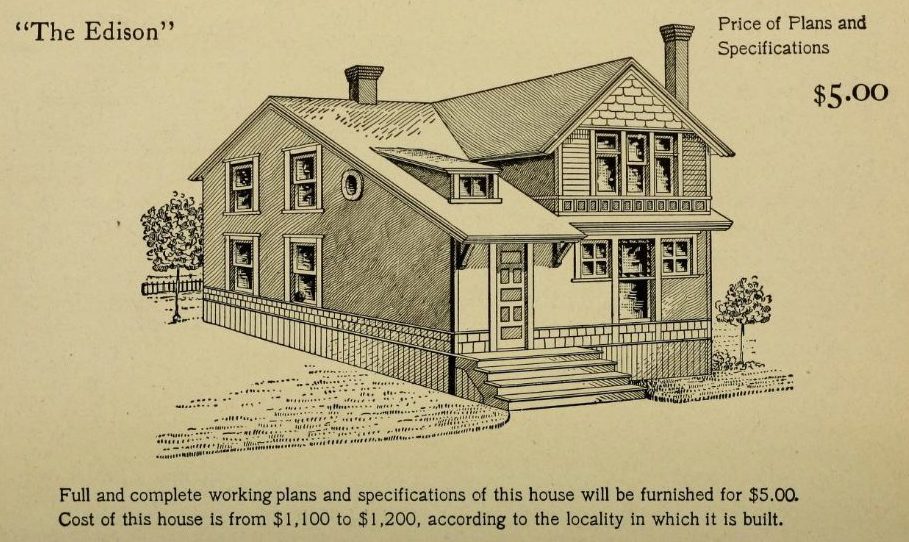Chapter 7 of Partners for Preservation is ‘Historical Building Information Model (BIM)+: Sharing, Preserving and Reusing Architectural Design Data’ by Dr. JuHyun Lee and Dr. Ning Gu. The final chapter in Part II: The physical world: objects, art, and architecture, this chapter addresses the challenges of digital records created to represent physical structures. I picked the image above because I love the contrast between the type of house plans you could order from a catalog a century ago and the way design plans exist today.
This chapter was another of my “must haves” from my initial brainstorm of ideas for the book. I attended a session on ‘Preserving Born-Digital Records Of The Design Community’ at the 2007 annual SAA meeting. It was a compelling discussion, with representatives from multiple fields. Archivists working to preserve born-digital designs. People working on building tools and setting standards. There were lots of questions from the audience – many of which I managed to capture in my notes that became a detailed blog post on the session itself. It was exciting to be in the room with so many enthusiastic experts in overlapping fields. They were there to talk about what might work long term.
This chapter takes you forward to see how BIM has evolved – and how historical BIM+ might serve multiple communities. This passage gives a good overview of the chapter:
“…the chapter first briefly introduces the challenges the design and building industry have faced in sharing, preserving and reusing architectural design data before the emergence and adoption of BIM, and discusses BIM as a solution for these challenges. It then reviews the current state of BIM technologies and subsequently presents the concept of historical BIM+ (HBIM+), which aims to share, preserve and reuse historical building information. HBIM+ is based on a new framework that combines the theoretical foundation of HBIM with emerging ontologies and technologies in the field including geographic information systems (GIS), mobile computing and cloud computing to create, manage and exchange historical building data and their associated values more effectively.”
I hope you find the ideas shared in this chapter as intriguing as I do. I see lots of opportunities for archivists to collaborate with those focused on architecture and design, especially in the case of historical buildings and the proposed vision for HBIM+.
Bios:
 Ning Gu is Professor of Architecture in the School of Art, Architecture and Design at the University of South Australia. Having an academic background from both Australia and China, Professor Ning Gu’s most significant contributions have been made towards research in design computing and cognition, including topics such as computational design analysis, design cognition, design communication and collaboration, generative design systems, and Building Information Modelling. The outcomes of his research have been documented in over 170 peer-reviewed publications. Professor Gu’s research has been supported by prestigious Australian research funding schemes from Australian Research Council, Office for Learning and Teaching, and Cooperative Research Centre for Construction Innovation. He has guest edited/chaired major international journals/conferences in the field. He was Visiting Scholar at MIT, Columbia University and Technische Universiteit Eindhoven.
Ning Gu is Professor of Architecture in the School of Art, Architecture and Design at the University of South Australia. Having an academic background from both Australia and China, Professor Ning Gu’s most significant contributions have been made towards research in design computing and cognition, including topics such as computational design analysis, design cognition, design communication and collaboration, generative design systems, and Building Information Modelling. The outcomes of his research have been documented in over 170 peer-reviewed publications. Professor Gu’s research has been supported by prestigious Australian research funding schemes from Australian Research Council, Office for Learning and Teaching, and Cooperative Research Centre for Construction Innovation. He has guest edited/chaired major international journals/conferences in the field. He was Visiting Scholar at MIT, Columbia University and Technische Universiteit Eindhoven.
 JuHyun Lee is an adjunct senior lecturer, at the University of Newcastle (UoN). Dr. Lee has made a significant contribution towards architectural and design research in three main areas: design cognition (design and language), planning and design analysis, and design computing. As an expert in the field of architectural and design computing, Dr. Lee was invited to become a visiting academic at the UoN in 2011. Dr. Lee has developed innovative computational applications for pervasive computing and context awareness in the building environments. The research has been published in Computers in Industry, Advanced Engineering Informatics, Journal of Intelligent and Robotic Systems. His international contribution has been recognised as: Associate editor for a special edition of Architectural Science Review; Reviewer for many international journals and conferences; International reviewer for national grants.
JuHyun Lee is an adjunct senior lecturer, at the University of Newcastle (UoN). Dr. Lee has made a significant contribution towards architectural and design research in three main areas: design cognition (design and language), planning and design analysis, and design computing. As an expert in the field of architectural and design computing, Dr. Lee was invited to become a visiting academic at the UoN in 2011. Dr. Lee has developed innovative computational applications for pervasive computing and context awareness in the building environments. The research has been published in Computers in Industry, Advanced Engineering Informatics, Journal of Intelligent and Robotic Systems. His international contribution has been recognised as: Associate editor for a special edition of Architectural Science Review; Reviewer for many international journals and conferences; International reviewer for national grants.
Image Source: Image from page 717 of ‘Easy steps in architecture and architectural drawing’ by Hodgson, Frederick Thomas, 1915. https://archive.org/details/easystepsinarch00hodg/page/n717
